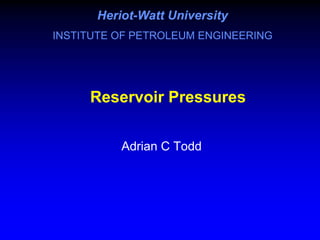
Res Eng PP Ch2(2).pdf
- 1. Reservoir Pressures Reservoir Pressures Adrian C Todd Heriot Heriot- -Watt University Watt University INSTITUTE OF PETROLEUM ENGINEERING Heriot Heriot- -Watt University Watt University INSTITUTE OF PETROLEUM ENGINEERING
- 2. Reservoir Pressures Reservoir Pressures Magnitude and variation of pressures in a reservoir are an important aspect of reservoir understanding during exploration and production phase
- 3. Reservoir Pressures Reservoir Pressures Oil and gas occur at a range of sub-surface depths. At these depths pressure exists as a result of: – the depositional process – the fluids contained.
- 4. Lithostatic Pressures & Fluid Pressures Lithostatic pressure grain to grain transmission of weight of rock sometimes termed geostatic or overburden pressure. Function of depth, density 1 psi./ ft Pov at depth D = 1.0 x D psi.
- 5. Lithostatic Pressures & Fluid Pressures Lithostatic pressure is balanced in part by the pressure of fluids within pores, pore pressure and by grains of rock under compaction. Unconsolidated sands, overburden totally supported by fluid pressure. In deposited rocks, like reservoirs, fluid pressure is not supporting the rocks but arises from the continuity of the aqueous phase from surface to the depth. Termed hydrostatic pressure.
- 6. Hydrostatic Pressure Imposed by a column of fluid at rest. Value depends on the density of fluid. Water - salinity 0.433 psi/ft - fresh water 0.45 psi/ft for saline water 55,000ppm. 0.465 psi for 88,000ppm Pfluid = rfluidDg g=acceleration due to gravity
- 7. Lithostatic Pressures & Fluid Pressures Hydrostatic pressure Lithostatic pressure
- 8. Hydrodynamic Pressure Arises as a result of fluid movement. This is the fluid potential pressure gradient which is caused by fluid flow
- 9. Fluid Pressure Dictated by prevailing water pressure in vicinity of reservoir. Normal situation dP/dD is the hydrostatic gradient Assumes continuity of water pressure from surface and constant salinity If pressure extrapolated to zero depth is atmospheric pressure - normal pressured reservoir 14.7 W water dP P D psia dD
- 10. Fluid Pressure-Normal Pressure Atmos. Pressure 0 psig. 14.7psia. Normal pressured reservoir
- 11. Fluid Pressure-Abnormal Pressure Under certain conditions fluid pressures are not normal. Overpressured reservoirs. Hydrostatic pressure greater than normal pressure Underpressured reservoirs Hydrostatic pressure below normal pressure
- 13. Abnormal Pressure Pressure Water-normal 0.45psi’ft. Overpressured 0.45psi/ft. 1000-2000psi N. Viking Graben-N.Sea
- 14. Abnormal Pressure 14.7 W water dP P D Cpsia dD C - constant positive - overpressured C - constant negative - underpressured
- 15. Causes of Abnormal Pressure Thermal effects-expansion or contraction of water Rapid burial of sediments Geological changes. Osmotic effects via salinity differences
- 16. Causes of Abnormal Pressure Geological changes
- 17. Abnormal Pressure Regional Trends
- 19. Fluid Pressures-Hydrocarbon Systems Hydrocarbon pressure regimes different since densities of oil and gas are less than water. 0.45 / water dP psi ft dD 0.35 / oil dP psi ft dD 0.08 / dP gas psi ft dD Pressure Depth 0
- 20. Pressure distribution for an oil reservoir with a gas-cap and oil water contact. Impermeable bed Path of well Pressure Gradient in aquifer Gradient in oil column Gradient in gas column Over pressured reservoir
- 21. Pressure distribution for an oil reservoir with a gas-cap and oil water contact.
- 22. Hydrocarbon Pressure Regimes Nature and magnitude of pressures and the position of fluid contacts important to the reservoir engineer. Data for fluid contacts from: Pressure surveys Equilibrium pressures from well tests Fluid flow from minimum and maximum depth Fluid densities from samples Saturation data from logs Capillary pressure from cores Fluid saturation from cores.
- 23. Techniques for Pressure Measurement Earlier tests for pressure logging have been replaced by open-hole testing devices which measure vertical pressure distribution in a well.
- 24. Examples of Pressure Measurement Pressure distributions before and after production provide important reservoir description information. Production from here Original pressure profile Pressure survey after production
- 25. Examples of Pressure Measurement After subsequent production Evidence of layering
- 26. Examples of Pressure Measurement Can also be used to indicate lack of hydrodynamic continuity.
- 27. Examples of Pressure Measurement As an interference test can indicate flow behaviour between wells.
- 28. Reservoir Temperature Earth temperature increases from surface to centre Heatflow outwards generates a geothermal gradient. Conforms to local and regional gradients as influenced by lithology, and more massive phenomena. Obtained from wellbore temperature surveys. Reservoir geothermal gradients around 1.6oF/100ft ( 0.029K/m). Because of large thermal capacity and surface area of porous reservoir, flow processes in a reservoir occur at constant temperature. Local conditions , eg around the well can be influenced by transient cooling or heating effects of injected fluids.